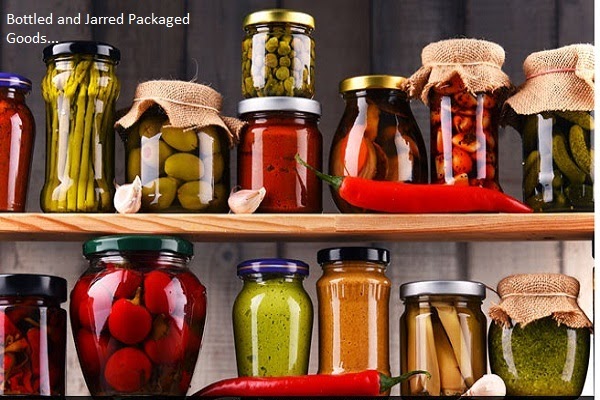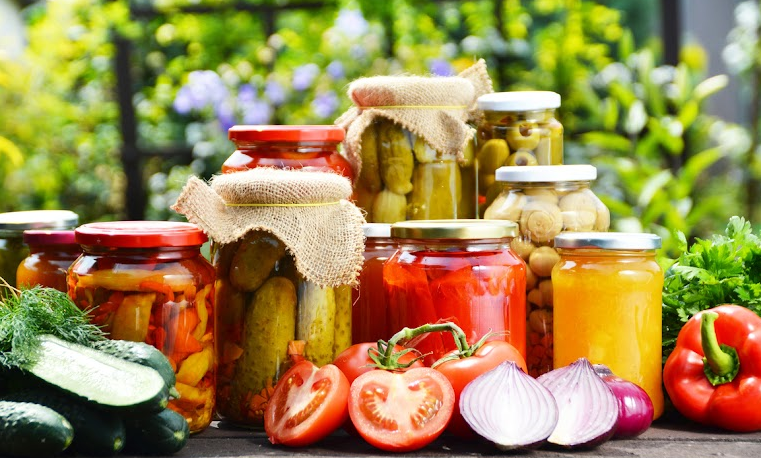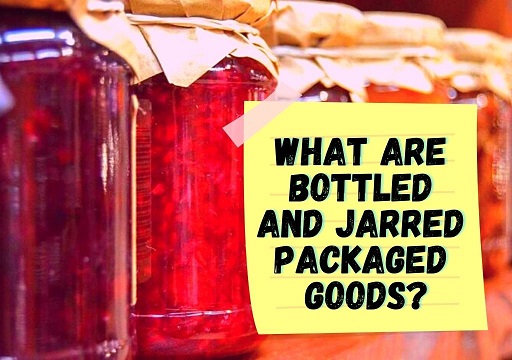
9 Types of Bottled and Jarred Packaged Goods– Types, Uses, Pros & Cons
In this blog article, you will find 9 types of bottled and jarred packaged goods. From fruit preserves and spices to relishes and jelly, this post will provide you with the basics of what these ingredients are, when they are typically used, the advantages and disadvantages of using them, any recipes that use them, the season where they are typically used and why that is, as well as a list of resources for more information on each type.
Introduction
When it comes to buying packaged goods, most people are familiar with the two main types of packaging: bottled and jarred. Both of these types of packaging have their benefits and drawbacks. Let’s take a look at what each type of packaging is good for and why you might choose one over the other.
When it comes to bottled goods, one of the benefits is that they can be stored at a more stable temperature than jarred products. This is because a bottle contains a fixed amount of liquid and cannot be opened or expanded. This makes them good for products that do not require movements, such as ice cream or soup.
Jared products, on the other hand, are great for products that need to be moved. They can be opened more easily and contain more room for expansion. This is good for things like yogurt, where you want to be able to add fruit or nuts. They also make it easy to portion out servings, which is important if you are trying to diet or watch your caloric intake.
Ultimately, it comes down to what you need the product for and which type of packaging will work best for that purpose.
Types of Bottled and Jarred Packaged Goods 1. Energy Drinks
Energy drinks are a popular type of packaged goods. They are made with stimulants, such as caffeine and sugar, to give you a quick burst of energy.
Some energy drinks are healthy alternative to soda, while others can be dangerous if consumed in excess. Be sure to read the labels before buying an energy drink!
Some types of energy drinks have been linked to health problems, such as anxiety and cardiac arrest. It is important to be aware of the dangers of energy drinks and to take caution when consuming them.
If you are looking for a quick and easy way to get energized, consider drinking an energizing juice or tea instead of an energy drink.
Energy drinks are a popular type of packaged goods that are sold in stores and online. Today Energy drinks are made from natural and artificial ingredients, and they contain caffeine, sugar, and other chemicals.
Energy drinks can be dangerous if drunk on their own, but they can also be dangerous when consumed in large quantities. Bottled Energy drinks can cause health problems like heart attack and stroke, and they can also contribute to obesity and diabetes.
It is important to be aware of the dangers of energy drinks, and it is also important to know the types of energy drinks available on the market. Common types of energy drinks include coffee energy drinks, fruit juice energy drinks, sports drink energy drinks, and tea energy drinks.
Types of Bottled and Jarred Packaged Goods 2. Water Drinking Containers
From water bottles to sports drinks, we are constantly buying and consuming bottled and jarred products. But what are the different types of containers?
Water bottles. A water bottle is typically a plastic container that holds water. They come in many different sizes and shapes, and can be filled from tap or a municipal water source.
A water bottle is typically a plastic container that holds water. They come in many different sizes and shapes and can be filled from a tap or a municipal water source. Sports drinks. A sports drink is a type of beverage made for athletes. They are designed to replenish electrolytes and contain vitamins, minerals, caffeine, and other trace nutrients. Sports drinks are often consumed during intense physical activity or during periods of high exertion (such as during a long run).
A sports drink is a type of beverage made for athletes. They are designed to replenish electrolytes and contain vitamins, minerals, caffeine, and other trace nutrients. Sports drinks are often consumed during intense physical activity or during periods of high exertion (such as during a long run). Watercolor bottles. Watercolor bottles are made from glass or plastic, and they hold liquid paint. They are used by artists to hold their
Types of Bottled and Jarred Packaged Goods 3. Ketchup
Did you know that ketchup is actually a type of bottled and jarred packaged well? Ketchup is made from tomato sauce, vinegar, spices, and other flavorings. It is a popular condiment in the United States and around the world.
Ketchup is available in many different varieties, including sweet, hot, garlic, and barbecue. It is also available in various types of containers, including bottles and jars.
Ketchup can be stored for long periods of time without spoiling. It is safe to eat even if it has been opened or unsealed. If you have any questions about the safety of ketchup, please consult your healthcare provider.
Ketchup can be a healthy addition to your diet if you are looking for a condiment that can add flavor to your meals. It is also an affordable option for food items that you might want to stock up on.
Types of Bottled and Jarred Packaged Goods 4. Mayonnaise
Mayonnaise is a popular condiment that can be used in many different dishes. It is made with oil, eggs, and water, and it can be stored in a variety of containers.
Mayonnaise can be stored in a number of different containers, including glass jars and plastic bottles.
Glass jar mayonnaise should be refrigerated, while plastic bottle mayonnaise should not be refrigerated. Mayonnaise can also be stored in the freezer, but it should only be frozen for short periods of time.
Mayonnaise should be handled carefully because it can be corrosive if it is not stored properly. Be sure to store mayonnaise in a cool and dry place away from light.
Types of Bottled and Jarred Packaged Goods 5. Salad Dressing
Salad dressing can be a very important part of your diet. It can add flavor and nutrients to your salad, and it can also help to make the salad more filling.
There are a variety of different types of salad dressing, and each one has its own unique flavor and texture.
Some of the most popular types of salad dressing include mayonnaise, vinegar, oil, and mustard.each has its own unique benefits and drawbacks.
Here are five tips for choosing the perfect salad dressing:
- Consider the flavor profile that you want to achieve. Some dressings are sweeter than others, and some are more acidic.
- Consider the texture of the dressing. Some dressings are thick while others are thinner. Decide which type of texture is best suited for your salad.
- Check the ingredients list. Many dressings contain unhealthy sweeteners or artificial ingredients, so be sure to read the label carefully.
- Compare prices. Different brands of salad dressing tend to cost different amounts, so be sure to compare prices before making a purchase.
- Test out different dressings before settling on a favorite one. Try out different types of dressings and see which
Types of Bottled and
There are a variety of different types of bottled and jarred packaged goods available on the market.
Some of the most common types of bottled and jarred packaged goods include soda, water, juice, beer, wine, and coffee.
Each type of bottled and jarred packaged good has its own unique features and benefits. For example, soda can be enjoyed cold or hot, while water can be consumed in many different ways.
Juices and beers are easy to store and can provide quick energy when needed. Wine can be enjoyed with dinner or as a Social lubricant, while coffee provides an afternoon pick-me-up.
There are a variety of different types of bottled and jarred packaged goods on the market today. Some of these products come in plastic containers that can be recycled, while others cannot.
Plastic bottles can be recycled into new plastic bottles, car parts, or other consumer products. However, some types of plastic bottles cannot be recycled and must be disposed of in a landfill.
Jarred packaged goods can also be recycled into new jars or other packaging materials. The glass jars used to package these products can be recycled into window panes or other decorative objects. This process is called “crushing” and it removes the lid and labels from the jar. The glass is then cut into small pieces and heated until it becomes liquid. This molten glass is then poured into mold cavities to create new jars.

What are bottled and jarred packaged goods?
Bottled and jarred packaged goods are a type of food that is packaged in a container that is sealed from the outside. These types of foods are often sold in stores, restaurants, and other locations.
The main component of bottled or jarred food is water, which is usually sealed inside the container. This water can be consumed as it is or it can be heated up and used to make PUR drinks or soup.
Some bottled and jarred foods are also preserved with chemicals, preservatives, and flavors. These additives can be harmful if they come into contact with your skin or eyes. It is important to read the label before buying any bottled or jarred product to make sure that it is safe for you to eat.
History of Bottled and Jarred Packaged Goods
Bottled and jarred packaged goods have a long history dating back to the days of ancient civilizations. They are used today as a way to preserve food and beverages.
Bottled and jarred packaged goods are made up of three main components: a container, a food or beverage, and a lid or closure. The container is usually made of glass or plastic. The food or beverage is placed inside the container, and the lid or closure is applied.
The history of bottled and jarred packaged goods goes back centuries. In ancient civilizations, people used bottles and jars to preserve food and beverages. Today, they are used as a way to store food and beverages for consumption later.
The main component of bottled and jarred packaged goods is the container. The containers can be made from different materials, such as glass or plastic. The most common type of container is the bottle. Bottles come in many different sizes, shapes, and colors, including water bottles, energy drinks bottles, goblets, wine bottles, soda cans, beer cans, juice boxes, and milk jugs.
The second most common type of container used in packaged goods is the can. Cans are usually round or oval in shape
Packaged Goods in Jars and Bottles
Packaged goods are becoming increasingly popular and for good reason. Jars and bottles provide a more convenient and sustainable way to store food.
One common type of packaged goods is the jarred product. Jarred products typically come in a variety of flavors, which makes them easy to store and access. They are also easy to recycle.
Bottled goods are another popular type of packaged goods. Bottled water, soda, juice, and other beverages are easy to transport and store. They are also eco-friendly because they don’t require any packaging or containers to be disposed of after use.
Packaged goods are increasingly being sold in jars and bottles. There are many reasons for this trend, but the most important one is that jars and bottles are more efficient and convenient to use.
One of the biggest benefits of packaged goods in jars and bottles is that they are easier to store. Jars and bottles take up less space than containers made of other materials, which means that they can be stored in more places. They also keep food products fresher for longer periods of time.
Packaged goods in jars and bottles also have another big benefit: they’re more likely to be consumed on-the-go. This is because they’re easier to transport and store. For example, Energy Drinks can be poured into a bottle and taken with you on a hike or bike ride.
Overall, packaged goods in jars and bottles are a great choice for convenience, storage efficiency, and on-the-go consumption.
Types of Bottles and Jars Used For Packing Food
Food is often packaged in a variety of different ways, depending on the type of food being packaged. Bottled and jarred foods are commonly packaged in bottles or jars. Bottled foods are often stored in cool, dark cabinets to help preserve them. Jars are also commonly used for packaging food. They are lightweight and can be stored in a wide variety of environments, including hot climates.
Bottled and jarred foods are usually packaged in a variety of different ways. Some bottles are designed to hold specific types of food, such as juice bottles that are designed to store fruits and vegetables. Other bottles can be used to store any type of food, such as water bottles that can be used to store food during a camping trip.
Jars are usually divided into two categories based on the type of food they are used to store: sealed and unsealed jars. Sealed jars have a lid that is fitted tightly onto the jar. This helps to prevent odors and bacteria from entering the jar. Unsealed jars do not have a lid, which allows the flavors and aromas of the food to permeate into the jar.
Jars come in many different colors and designs, depending on the type of food

Different Types of Bottles & Jars
There are a variety of types of bottled and jarred foods. Some bottles are made out of plastic, while others are made of glass. Some jars are made out of glass, while others are made out of aluminum.
The most common type of bottle is the plastic bottle. These bottles are typically used for drinks, such as milk and fruit juice. Plastic bottles can be recycled, which means they can be converted into new plastic bottles.
Glass bottles are also common. These bottles are typically used for milk, water, and other drinks. Glass bottles can be recycled, but they must be broken down into small pieces before they can be recycled.
Aluminum bottles are becoming more popular than ever before. These bottles are often used for food products, such as milk and yogurt. Aluminum bottles cannot be recycled, but they can be composted or burned.
Advantages & Disadvantages of Bottled and Jarred Packaged Goods
One of the main advantages of bottled and jarred packaged goods is that they are portable. This means that you can take them with you wherever you go.
Another advantage of bottled and jarred packaged goods is that they are easy to store. You can simply put them in a cabinet or pantry, and they will not take up much space.
Finally, bottled and jarred packaged goods are convenient to eat. You can just grab a bottle or jar and start eating without having to prepare anything first.
There are a variety of benefits to storing food in a bottled or jarred package. One of the most obvious advantages is that it’s easy to store and transport food.
Bottled and jarred food can also be stored at a safe temperature. This is especially important if you want to store food for an extended period of time, such as during the summer months.
Another benefit of bottled or jarred food is that it’s easy to find what you’re looking for. If you have a large pantry or refrigerator full of cans and boxes, it can be hard to know where to start when you want to eat something specific. With bottled and jarred food, all you need is a search engine and you’ll be able to find what you’re looking for.
Finally, bottled and jarred food is environmentally friendly. When you buy food packaged in this way, you’re not contributing to waste pollution levels. Instead, your food will stay fresh longer thanks to the packaging materials.
Importance of Packaging
Packaging is a key factor in the success of any product. Without good packaging, products can easily be damaged during shipment and storage.
Bottled and jarred packaged goods are especially vulnerable to damage. The bottles and jars can easily be broken, bent, or even pierced if the packaging is not designed properly.
Fortunately, there are a number of different types of packaging that can protect products from damage. Bottled and jarred products can be packaged in plastic bags, boxes, cartons, or even cans. Each type of packaging has its own advantages and disadvantages.
Boxes and cartons are the most efficient packaging options because they require the least amount of space per item. However, they are the least resistant to damage. Boxes can be crushed, bent, or even torn open if they are not secure enough.
Canned products are the least efficient packaging option because they require more space per item. However, cans are very durable and protection against damage is usually guaranteed.
Packaging options for bottled and jarred products vary depending on the product and carrier. However, all packaged goods should be protected from damage during transportation and storage to ensure a high-quality product that meets customer expectations
Reasons Why People Choose Bottled & Jarred Goods
People have been consuming packaged goods for centuries, and there are a variety of reasons why they choose to consume them bottled or jarred. Some people like the convenience of having these products on hand, while others may prefer the environmental benefits of packaging their food in a less wasteful way. Whatever the reason, there are a variety of types of packaged goods that people enjoy.
So what are some of the most popular types of packaged goods? Here are three examples:
Canned Goods: canned foods are one of the oldest types of packaged goods. They’re easy to store, transport, and cook, which is why they remain one of the most popular varieties today. Canned fruits, vegetables, and meats make great shelf-stable snacks or meals.
Canned Soup: Many people enjoy canned soup for its nostalgic appeal. Many old-fashioned recipes call for canning soup as a means of preserving it for later. Canned soup can be taken everywhere you go, making it a great option for busy people on the go.
Packaged Cereal: Most cereal is prepped and ready to eat when it arrives at your doorstep. You only need water to make it, which makes it an ideal morning meal or snack
Why bottled and jarred packaged goods are better for consumers?
Bottled and jarred packaged goods are better for consumers because they are safer than food that is sold in the open.
Food that is sold in the open is at risk of being contaminated by pests, bacteria, and other contaminants. This is especially true of food that is sold at food markets or on street stalls.
Bottled and jarred packaged goods are also at risk of being contaminated by harmful chemicals. However, bottled and jarred packaged goods are typically stored in a controlled environment, which limits the amount of contamination that can occur.
In addition, bottled and jarred packaged goods are often delivered to consumers fresh, which is better for their health. Food that is stored for long periods of time often loses nutritional content and taste.
Packaged Goods That You Should Avoid Buying
If you’re looking to reduce your intake of packaged goods, you should avoid buying any that are in plastic bottles or jars. These types of products are often full of chemicals and additives that can have harmful effects on your health.
Instead, try buying packaged goods that are either in paper or cardboard packaging. These products are typically healthier and environmentally friendly. They also tend to be less expensive than products that are packaged in plastic.
If you still want to buy packaged goods, try to buy those that are made with natural ingredients. This will help to reduce the amount of harmful chemicals that are used in the packaging process.

Conclusion on Bottled and Jarred Packaged Goods
When it comes to bottled and jarred packaged goods, it is important to remember that it is always safest to consume them fresh. This is because if a product is stored in a sealed container for an extended period of time, bacteria can grow and cause food poisoning.
Furthermore, many packaged foods contain additives that can be harmful if ingested in large quantities. For example, high levels of salt can lead to high blood pressure, while artificial ingredients can mess with your immune system. It is therefore important to read the ingredients list before you buy any packaged food to make sure that you are ingesting what you believe is safe.
When it comes to bottled and jarred packaged goods, there are a few things to keep in mind. For example, bottled water should be stored in a cool, dark place. This will help to preserve the flavor and quality of the water.
Similarly, canned goods should also be stored in a cool and dark place. The canning process can cause harmful chemicals to form, which can make food unsafe to eat.
Finally, it is important to read the labels on packaged goods. Some products may contain high levels of sugar or unhealthy fats. If you are looking for healthier options, it is best to look for packaged goods that are labeled as being healthy or artificial-free.
FAQs about Bottles and Jarred Packaged Goods
- What is a bottled product?
A bottled product is a type of packaged good that is typically filled with extract or liquid and then sealed inside a plastic or glass bottle or jar. Beverages, dietary supplements, cosmetics, soaps, foods, and other products are all examples of bottled products.
- What are the different types of packaged goods?
There are three main types of packaged goods: consumables (foods and drinks), therapeutic (healthcare and medical products), and non-therapeutic (gifts, home decor). Each type of packaged good has its own set of pros and cons. Let’s take a look at each one in more detail.
Consumable products are meant to be used up quickly and consumed on the spot. They often have a high sugar content and are low in nutrients. This makes them dangerous if they’re left out of the fridge for too long or if they’re unprotected from sunlight or heat. They’re also commonly subject to contamination due to mold or bacteria growth.
Therapeutic products are intended to help people improve their health. Often they’re more expensive than consumables, but they have a longer shelf life and can be stored

